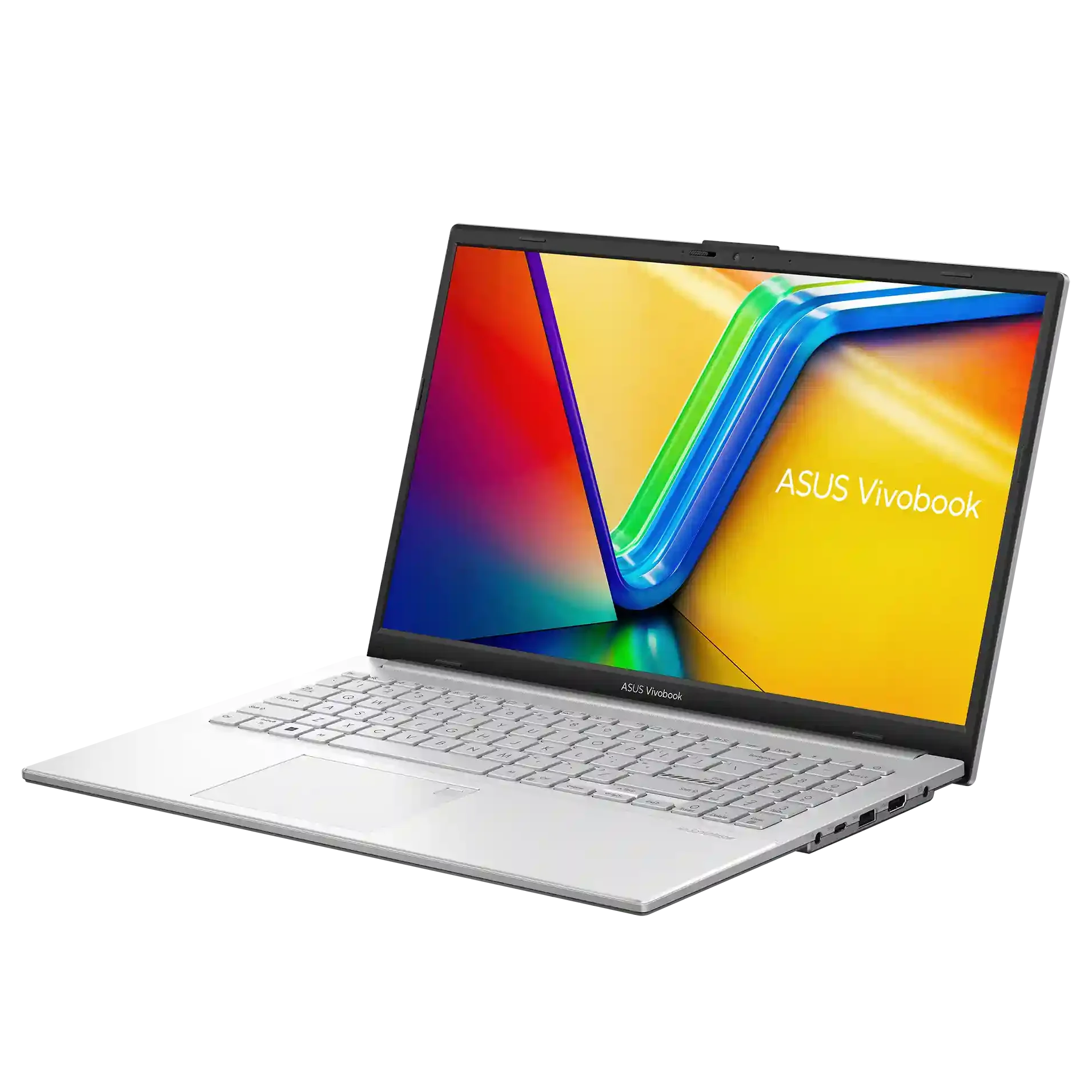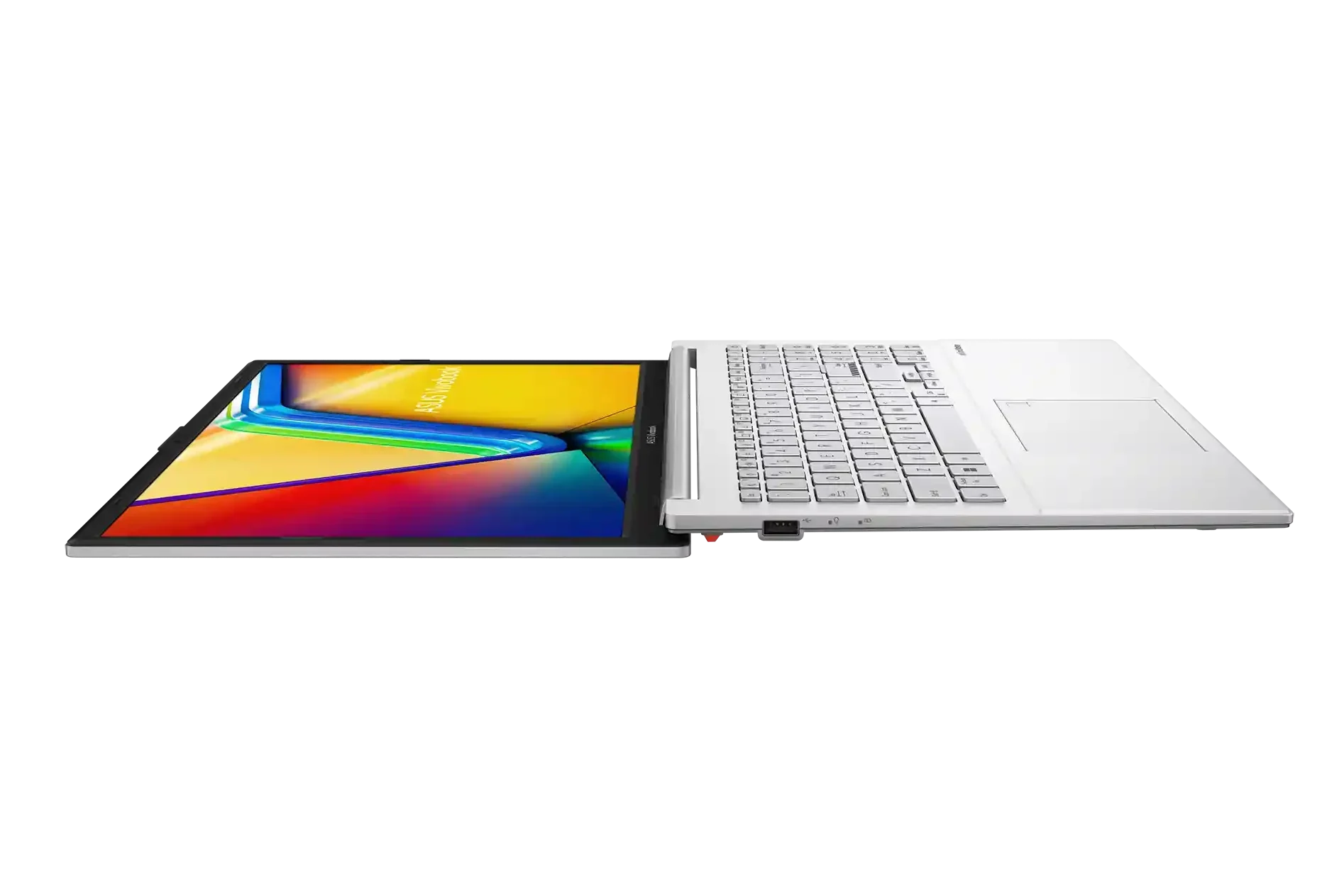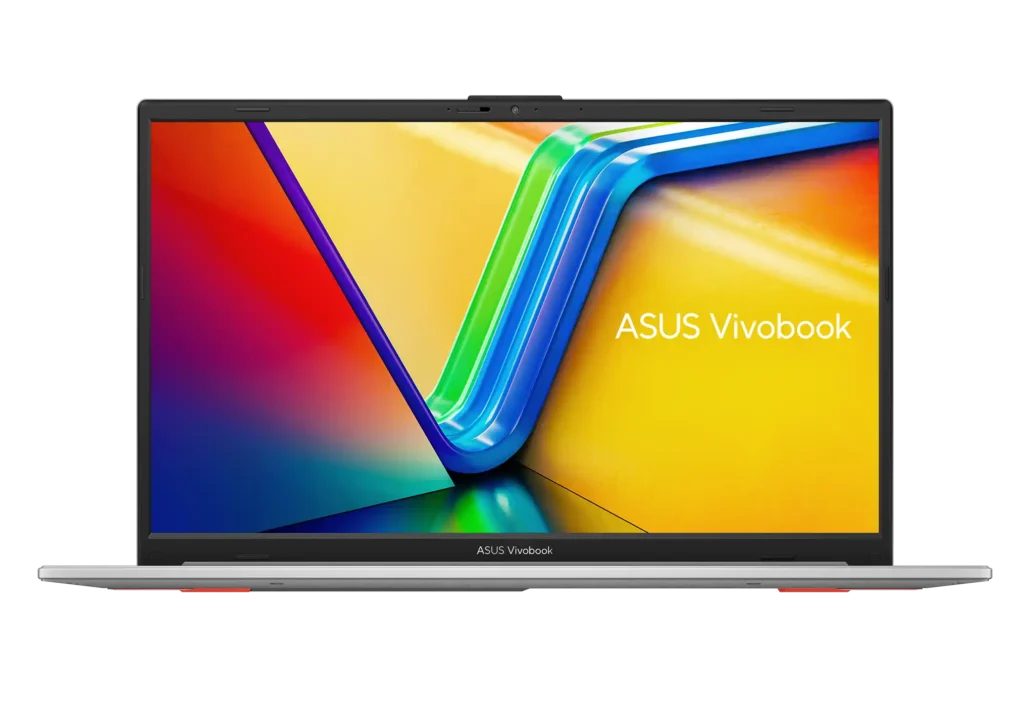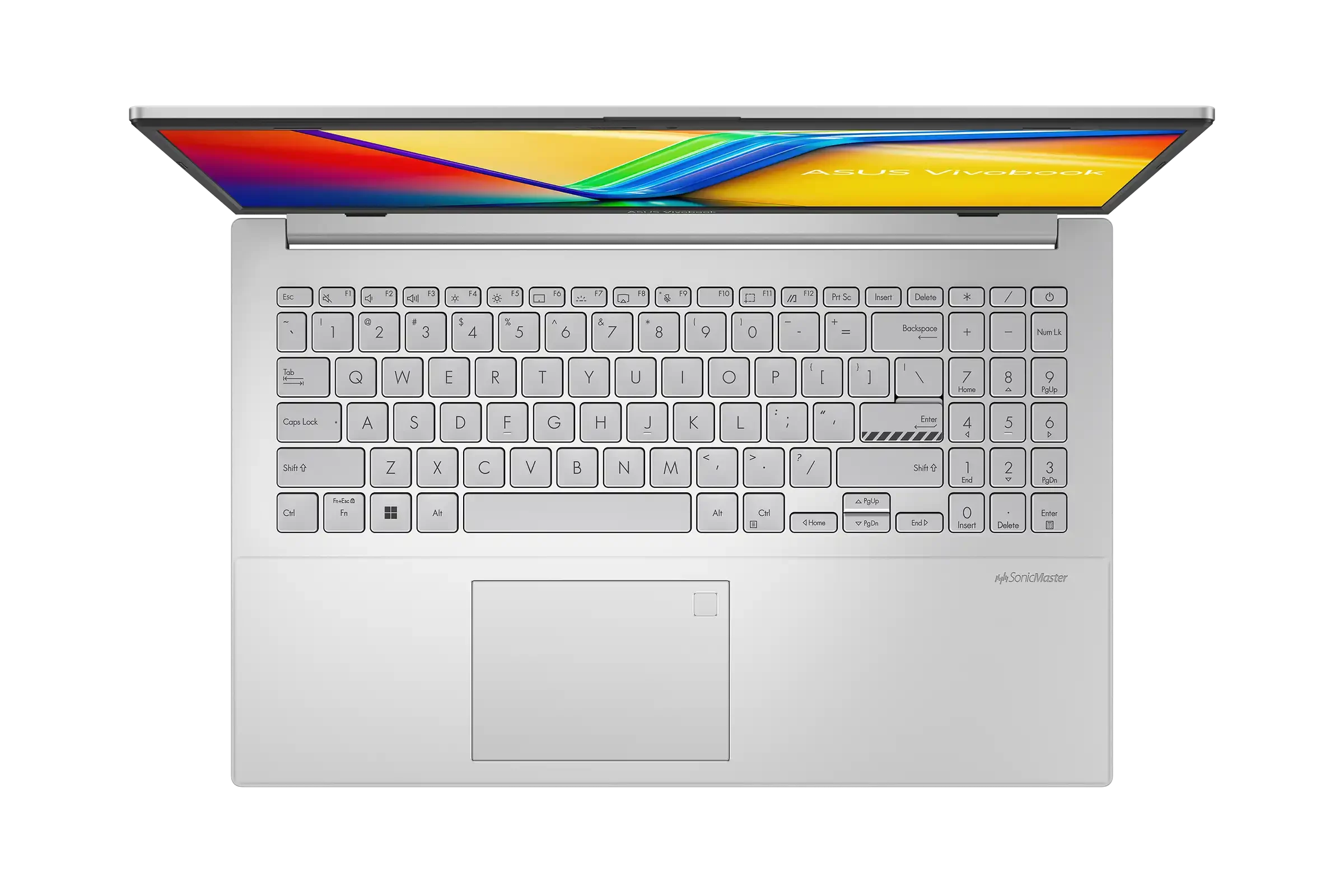Today, I have the ASUS Vivobook Go 15 (E1504F), which offers exceptional value for its price. Unlike the higher-end Vivobook models that feature OLED panels as premium upgrades, the Vivobook Go lineup now includes these glossy screens as standard. This addition of a vibrant display to a budget-friendly laptop priced at Rs 52,792.50 significantly enhances its appeal.
While this laptop may not be appropriate for disturbing professional tasks like coping with huge spreadsheets, developing complicated income presentations, or editing huge-scale videos, it excels as a versatile media device. Below is my comprehensive evaluation.
Asus Vivobook Go 15 Design
The design of the Vivobook Go 15 fits seamlessly within the broader Vivobook lineup, featuring a familiar silver aesthetic and a boxy shape akin to its pricier counterparts.
Constructed entirely of plastic, as expected at this price point, the laptop exhibits some flex but remains lightweight at 1.6kg, making it convenient to carry in one hand or transport in a bag throughout the day. Despite its plastic build, the Vivobook Go 15 maintains the premium appearance associated with its siblings, with the display alone giving the impression of a higher price tag.

While the laptop is predominantly plastic, Asus has prioritized sustainability by packaging it in a slim and recyclable cardboard sleeve. The packaging emphasizes the business enterprise’s environmental tasks, incorporating a QR code for a more desirable unboxing experience thru augmented truth. Although the handle is plastic, the packaging can be easily disposed of in recycling bins.

The ASUS Vivobook Go 15 OLED measures 17.9 mm in thickness. Compared to the average thickness of laptops with a display size between 15.0 and 15.9 inches in our database, which is 20.2 mm, the Vivobook Go 15 OLED can be considered relatively slim for its category.
Display
The Asus Vivobook Go 15 OLED comes prepared with a spacious 15.6-inch OLED show, which offers vibrant and correct colors proper out of the box. Unlike conventional LED or LCD panels, OLED technology ensures regular coloration accuracy across extraordinary brightness levels, overlaying 99.7% of the sRGB, 99.5% of the Adobe RGB, and 99% of the DCI-P3 shade areas.

One of the super blessings of OLED shows is their capability to hold battery life through turning off unused pixels, particularly in darkish regions of the show. This function is mainly useful while the use of Dark Mode or watching movies with letterboxed content, taking into account longer usage on a unmarried charge.
Moreover, OLED generation complements assessment by handing over deep blacks alongside bright colors, creating an immersive viewing revel in. However, the sleek nature of the display may result in glare and reflections beneath amazing daytime or harsh indoor lights situations, necessitating higher brightness settings that might impact battery life.

While the Vivobook Go 15 OLED might not meet the needs of expert video and picture enhancing due to its overall performance obstacles, it excels in presenting a fun viewing experience for various content sorts, such as expert photography, streaming services, and circle of relative’s movie nights.
The inclusion of OLED generation also elevates the pc’s multimedia abilties, probably liberating up the family TV for other makes use of. Despite its small down-firing speakers positioned on the base, the laptop offers respectable audio pleasant, although higher volumes might also result in a few loss of element. Overall, the Vivobook Go 15 OLED gives a visually beautiful show suitable for quite a number amusement activities.
Keyboard
The keyboard on the ASUS Vivobook Go 15 offers a full-sized layout, albeit slightly cramped due to the 15-inch form factor. While this may require some adjustment, especially for users accustomed to larger keyboards, it’s a common experience when transitioning between different keyboard layouts.
The touchpad boasts an easy floor and responsive clicking mechanism, masking the whole region for handy use. Some models might also encompass a built-in fingerprint reader inside the touchpad for brought safety and convenience.

However, the typing experience on this keyboard is rather basic, utilizing low-profile rubber dome switches typical for laptops in this price range. While this is expected, the keystrokes may feel sluggish and the return to neutral position could be abrupt for some users, especially during the initial period of use.
If you’re simply replacing a previous budget laptop, you may not notice any significant issues with the keyboard. However, if you’ve recently used a different keyboard, such as one in an office setting, you might find the typing experience lacking compared to others. Additionally, the lack of backlighting could be inconvenient for users in dimly lit environments, a drawback not unique to this model.
Connectivity
Connectivity options on the ASUS Vivobook Go 15 are conveniently located on both sides of the device. On the right side, you will find a barrel charger, complete-sized HDMI port, USB-A 3.2 Gen 1 port, USB-C 3.2 Gen 1 port, and a headphone jack. Meanwhile, the left side houses a slower 2.0 USB-A port, primarily used for charging wireless mice or similar devices.

While the USB-A port on the left may seem slightly protruding and out of place, it’s positioned similarly to the multi-port array on the right side. Both sides feature large orange rubber feet to prevent the laptop from touching the table surface directly.

Regarding wireless connectivity, the ASUS Vivobook Go 15 is equipped with Bluetooth Standard v5.1, which although not the latest iteration, still offers reliable performance. With each sub-generation within the Bluetooth V5.x series, improvements are made in energy efficiency, reliability, and security features.
In terms of WiFi, the laptop utilizes a general that offers theoretical speeds of up to 3.5 Gbps (437.5 MB/s) and real-world speeds of up to at least one Gbps (125 MB/s). While this may not be the latest WiFi standard, it offers sufficient speed for everyday tasks. However, it’s worth noting that laptops with the latest WiFi v7 standard offer significantly faster speeds of up to 40 GB/s, making them ideal for users seeking top-tier wireless performance.
Battery Life
The ASUS Vivobook Go 15 offers impressive battery performance, with a runtime of approximately 8 hours under normal usage conditions. This consists of responsibilities along with workplace work, video calls, and internet surfing. Even with occasional increases in brightness or short breaks for activities like watching YouTube or playing Solitaire, the laptop can easily last through most of the day without requiring a recharge. The included 65W charger, although compact and convenient, relies on a barrel-style connector for charging, which may not be as modern or universally compatible as other charging methods.
When it comes to recharging, the ASUS Vivobook Go 15 takes around two hours to reach a full charge, which is reasonable considering its battery capacity. While it may not be the fastest charging speed available, it balances out by maintaining its battery life effectively during usage. Additionally, if you want to increase your battery existence in addition, adjusting settings which include screen brightness and activating battery-saving modes permit you to surpass the eight-hour mark.
However, this may require compromising on some usability additives, particularly for obligations that demand better strength consumption. The pc gives a commendable balance amongst battery sturdiness and recharge pace, making sure productiveness without frequent interruptions for charging.

Performance
Equipped with an Intel Core i3-N305 processor, the ASUS Vivobook Go 15 delivers decent performance thanks to its 8GB of memory and a speedy 256GB NVME SSD. While the Core i3-N305 may not be the most powerful processor, it pairs well with the available memory and SSD to provide sufficient performance for everyday tasks.
It’s well worth highlighting that the SSD offers proper storage capabilities, not like the slower eMMC flash garage discovered in a few finances’ laptops. This ensures smoother performance and prevents slowdowns commonly associated with limited storage capacity.
Despite not offering a vast amount of storage, the ASUS Vivobook Go 15’s configuration is suitable for tasks like school projects and streaming media content. However, it is able to struggle with more traumatic programs and tasks that require considerable processing electricity, such as heavy picture enhancing or video rendering.
Benchmark tests reveal modest performance levels, with the Intel processor scoring 1187 and 2878 in Geekbench’s single and multicore tests, respectively. While it can handle basic productivity tasks and light multitasking, it may not meet the demands of complex office spreadsheets or graphic-intensive workloads.
Furthermore, the computer’s 8GB of reminiscence can every now and then attain its potential throughout light usage, doubtlessly impacting performance while going for walks more than one application simultaneously. Therefore, it may not be suitable for tasks that involve sizable multitasking or useful resource-heavy applications.
For users requiring higher performance levels, alternatives like AMD Ryzen-powered laptops or previous-generation ASUS Vivobook models equipped with more powerful processors may be more suitable options. These alternatives offer better performance competencies at a barely higher price factor, making them feasible picks for customers with greater annoying computing desires.
GPU
The ASUS Vivobook Go 15 OLED is equipped with an integrated GPU, specifically the Radeon 610M. Integrated GPUs offer value and power efficiency advantages in comparison to devoted GPUs, despite the fact that they may no longer provide top-quality performance for image-extensive tasks like gaming or video rendering. The Radeon 610M has a floating point performance of 0.56 TFLOPS and features system-shared memory.
Storage
The standard configuration of the ASUS Vivobook Go 15 OLED includes a 128GB SSD (M.2 type), which provides fast data transfer speeds of up to 3.5 GB/s. While having more storage is beneficial, it typically comes at an additional cost. Fortunately, the storage in the ASUS Vivobook Go 15 OLED is upgradeable, allowing users to easily replace it with a larger capacity SSD when needed. Compared to older SATA SSDs, NVMe SSDs offer considerably faster performance, with SATA SSDs achieving speeds of as much as 550 MB/s.
Pros
- Affordable price for an OLED display.
- Long-lasting battery.
- Decent performance for beginners.
- Spacious screen size.
Cons
- Simple typing experience lacking backlighting.
- Non-expandable memory and storage.
- Absence of an integrated SD card reader.
- Low webcam resolution at 1280 x 720.



